
|
| The Kharga Oasis must be one of the most beautiful places in the world, especially at sunset; everything you see at this "green island in the middle of a yellow ocean of sand", is natural! Whether you are sleeping under the stars, or just relaxing between the high palm-trees, you will find a feeling of integration with the environment. The first time I saw the El-Kharga Oasis, a bright light came to my eyes and I could not overcome the emotion, even I wondered "what better place to go than El-Kharga Oasis. The Kharga Oasis, the capital of the governorate of the new valley, or Al Wadi Al Gadeed, in Egypt, hosted inhabitants since prehistoric times and it is still the most populated oasis of Egypt until today. The location of Al Kharga Oasis Al Kharga is located 232 kilometers to the South of Asyut, 550 kilometers to the South of Cairo. The oasis is located to the west of the Nile valley. Al Menya, Asyut, Sohag, Qena, occupies the Eastern border of the governorate, while the governorate of Matruh occupies its Northern borders, and the Egypt international borders with Libya is located on the Western edge of the governorate of Al Wadi Al Gadeed. Kharga. It is the largest of the Western Desert oases and the furthest from Cairo. Luxor is, in fact, the closest town to it. The Ancient Egyptians knew it as the Oasis of Thebes or the Southern Oasis. Surrounded by mountains and long rows of sand dunes there are a number of passes that lead into the oasis which have been used by travellers through the ages. The arc-shaped, barchan dunes would long ago have smothered the oasis if it were not for the mountains. Even today they threaten the cultivated land and cause families in some areas to build extra stories onto their homes to stay above the level of the encroaching sand. Kharga was once under the sea and there are still many fossils to be found and the herbivorous dinosaur Ornithischian was also found here. Another feature unique to Kharga, are the large group of yardangs. A yardang is a wind-abraded ridge typically about three times longer than they are wide, and when viewed from above, resemble the hull of a boat. The Kharga oasis, in the Arabic language, which means the "outside" is a wide depression that extends over an area of 220 kilometers from north to south and comprises the whole Southern Egypt except for the part that is beside the red sea. The new valley governorate is one of the most important geographical locations in Egypt as it is considered to be one third of the whole area of the country. The oasis of Kharga is considered to be a major administrative center and the seat of the governorate of the New valley or Al Wadi Al Gadeed. The history of the Kharga Oasis The Kharga Oasis was an important transit point for the desert caravans since the period of the 12th dynasty (1786 BC – 1665 BC). This was a transition period in the Egyptian history when the Hyksos had control over Northern Egypt and the Pharos ruled over Southern Egypt and the Nubia. The Kharga Oasis was always considered the Southern and Western Gate of Egypt. It connected Egypt to Southern Africa through the forty days road. In August 2010, the Egyptian-American archaeological mission discovered the ruins of the most ancient residential area discovered in Sothern Egypt until now and it goes back to the second intermediate period. These ruins that the mission has found reflect that Al Kharga was a major administrative and services body at that point in history. The mission has found the ruins of some huge buildings, passageways, and a large bread bakery. These ruins go back to the Middle Kingdom (2134-1569 BC) and the scholars believe that this civilization went on until the new Kingdom (1569-1081BC). however, the area really flourished during the 13th dynasty, the second intermediate period (1664-1569 BC), and the 17th dynasty (1600- 1569 BC. During the third and Forth century AD, a lot of Egyptian Christians resorted to the Kharga Oasis and the surrounding area to escape from the unjust Romans who persecuted the Copts of Egypt because of their Christian beliefs and religion. The Copts lived in peace in the Kharga Oasis and left remarkable monuments like the cemetery of Bagawat. Al Kharga Oasis Today Although the Kharga Oasis occupies around one third of the whole lands of Egypt, it contains the least population density in the whole nation with around 20,000 inhabitants nowadays and a population density of 4 persons in each square kilometer. The reason behind this is the vast areas of the deserts surrounding the Kharga Oasis, the Eastern and Western Deserts of Egypt. Tourism is not considered a major activity for the people living in Kharga. Most of the people of the Kharga work in normal jobs like the inhabitants of Cairo, Alexandria, and the other cities of Egypt. Al Wadi Al Gadeed also hosts one of the largest phosphates mime in the world in the area of Abu Tartour. The Kharga Oasis is connected to the Nile valley with a set of roads. The first one goes from Asyut to the Kharga, the second goes from Farafra, to Dakhla, to Kharga. There is also a direct flight from Cairo to the Wadi Al Gadeed Airport in the Kharga Oasis. Overview Kharga is the most modernized of Egypt's western oases. The main town is highly functional with all modern facilities, and virtually nothing left of old architecture. Although framed by the oasis, there is no oasis feeling to it; unlike all other oases in this part of Egypt. There is extensive thorn palm, acacia, buffalo thorn and jujube growth in the oasis surrounding the modern town of Kharga. Many remnant wildlife species inhabit this region. |
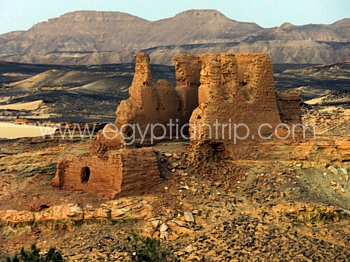 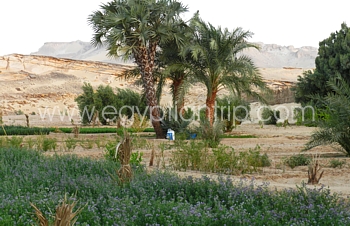    |
What to visit in Kharga oasis? 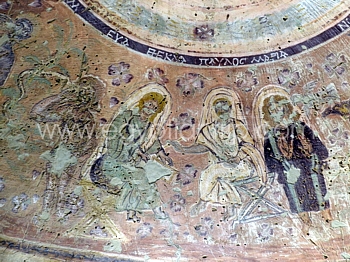 The museum of Antiquities of Al Kharga The museum of Al Kharga hosts a lot of the items that were found all over the archeological sites of the governorate. This includes a statue of Horus, some Pharonic reliefs, and a collection of Coptic pottery. The museum is open daily from 9 till 3 and it is located in the city of Al Kharga. The Oasis of El-Kharga was a prosperous place during ancient times and was linked with the Nile Valley by many routes. The Greek historian Herodotus mentioned that the great Persian King, Campuses, sent a huge army (about 50,000 men) from Thebes in order to destroy the Oracle Temple of Amon-Zeus at Siwah. The huge army reached the El-Kharga Oasis, was provided with food and water, and then they continued their march towards Siwah, but the campaign vanished and no one can tell what really happened, even today! Some historians suggest that the Persian army was lost in the desert and were sunk in the Great Sea Of Sand, which extends along the borders between Egypt and Libya. Nowadays El-Kharga is famed for the large number of palm-trees, pigeon-houses, farms, fields, monuments, wells, artisans, traditional handcrafts, and honey-coloured hills, which can be found here.  There is also another attraction - riding camels, which is considered by many tourists and visitors, an adventure in itself. On the rocks of some sites some graffiti, left by tourists to commemorate their visit to that beautiful Oasis. Pure springs and natural wells completely unpolluted by chlorine or other chemicals are scattered in several locations in the Oasis. The local people seem to be "at your service"; they are very kind and give visitors the feeling that they are very welcomed. The life there is simple, but extremely satisfying! The Temple of Hibis The temple of Hibis is located approximately one kilometer to the north of the city of Al Kharga. This temple is considered of significant importance as it represents different stages of the Egyptian history. The Pharonic, Persian, Ptolemaic, and Roman eras are well reflected in this ancient beautiful temple. The temple of Hibis was originally constructed during the reign of the 26th dynasty, which was the last native dynasty to rule Egypt before the Persian conquest in 525 BC. The period of this dynasty is also called the Saite Period after the city of Sais, where its pharaohs had their capital.  The temple was built for the worship of the holy triad (Amun- Mut- Khonsu). The construction work started under the rule of Iris and then Ahmos II. However, most of the construction works were completed during the Persian or the Hyksos occupation of Egypt specifically during the reign of Darius I (522 BC. The temple Of Hibis was enlarged during the period of Nectanebo I (380 -362 BC) and Nectanebo II (360 -343 BC). Ptolemy II (285 -246 BC) has also added the two outmost portals. The Necropolis of Al-Bagawat One of the World's Oldest Christian Cemetary The Cemetery of Bagawat is located three kilometers to the North of the city of Al Kharga behind the Temple of Hibis. This cemetery got its name from its style of architecture as most of the tombs there were constructed in the form of domes, or "Qubwat" in Arabic which transformed afterwards into Bagawat. This cemetery hosts one of the most important and most ancient Christian churches in the whole world. The cemetery dates back to period ranging from the second to the seventh century AD when the Christians escaping from Northern Egypt resorted to the Kharga Oasis. It contains 236 tombs constructed as small domed chapels with a central church in the middle which is considered one of the most ancient Coptic Churches of Egypt. The cemetery occupies a surface area of 10,000 squares and the most important tombs of the cemetery is the tomb of Exodus which represents the Israelis going out of Egypt and the Pharos forcing them out of the country. There is also the tomb of "peace' that contains reliefs of Jacob, the Virgin Mary, Saint Paul, and Saint Takla. Other tombs display many colorful Coptic inscriptions and writings that demonstrate the Coptic life during this period. The temple starts from the East with the sacred lake and the ports. Then there is the Roman gate that dates back to the Roman emperor, Galba, who built this gate in 69 AD. Afterwards, there is the rams' passageway that leads to the major gate of the temple. Afterwards, there is the Sanctum of the temple with its remarkable unique inscriptions. Temple Fort of An-Nadura Drive a little over a mile outside of Al-Kharga to the Roman temple and fortress ruins for a brilliant view of the desert. Note the paintings of women playing percussion instruments on the temple walls.  Gebel Al-Tayr Gebel Al-TayrPrehistoric and Coptic Paintings A couple of kilometres north of the Necropolis of Al-Bagawat – one of the oldest Christian cemeteries in the world – in Kharga Oasis, lies the "Mountain of the Bird", better known as Gebel Al-Tayr. This intriguing hill boasts some of the western desert's oldest prehistoric drawings and inscriptions, but also and most importantly, Coptic engravings that date back to the 4th, 5th and 10th centuries. Historians believe these inscriptions were made by desert hermits who lived in the area. Their writings, next to which they've drawn a cross, consist of prayers and invocations. However, the absolute must-see in Gebel al-Tayr is located at the top of the mountain in the form of a cave: the Cave of Mary. The small grotto is home to a historical masterpiece: a wall painting representing the Madonna and Child, next to which a prayer has been scripted in yellow and red lines. Deir Al-Kashef Monastery Majestic Coptic Ruins in the Western Desert Strategically situated to overlook a crossroad of the Western Desert, the Monastery of Al-Kashef stands over the cliffs north of the Necropolis of Al-Bagawat, near the oasis of Kharga. Walk or drive from the necropolis to see impressive mud-brick ruins and fallen arched corridors that date back to the early Christian period. Qasr al-Labeka Was one of the largest fortresses in Kharga. Guarding the Darb al-Arbain it is in spectacular location. There are still two aqueducts, some rock-cut tombs and three buildings- the fortress itself, and two temples -to be seen. 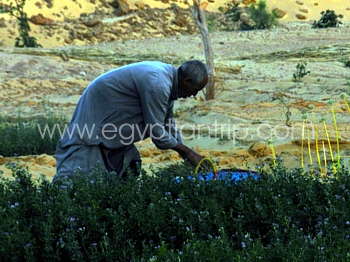 The Fortress of Ain Um Dabadib The Fortress of Ain Um DabadibAin Um Dabadib The stunning fortress of Ain Um Dabadib is an ancient high rise monument that sits below an escarpment but stands 220 meters above the desert floor. The fortress was occupied for thousands of years; scattered pots and ceramics that date back across Egyptian history can be found around the fort. Baris Was an important trading centre on the Darb al-Arbain. Its inhabitants traded directly with Esna in the Nile Valley. At New Baris, 2km away, it is possible to see the abandoned remains of a project that was intended to revitalise the oasis. Designed by architect Hassan Fathy, it was well laid out and practically designed for desert living. Building was never resumed after it was interrupted by the Six Day War in 1967. The Temple and Fortress of Dush 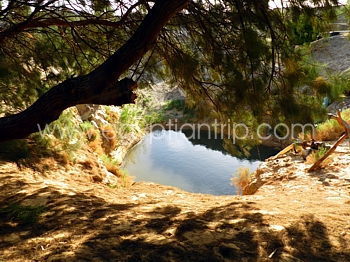 One of the oldest and most impressive fortresses of the Western Desert lies about 100 km south of Kharga Oasis, in the very same location of the old town of Kysis which remains are still being excavated to this day by teams of archaeologists. Dating back to the 2nd century AD, the imposing fortress and temple of Dush were completed around 177 AD at the intersection of five major desert routes, including the road that lead to the temples of Esna and Edfu. The fortress' solid architecture is a testimony to its importance; the building included as much as four storeys underground. The adjoining sandstone temple dates back to the 1st century and was dedicated to the Ancient Egyptian gods Isis and Serapis. Its walls were adorned with beautiful gold decorations in the past, most of these are sadly gone today but a few remain on the inner walls of the temple. If you're not visiting the temple on a guided tour or safari, the best way to get to Qasr Ad-Dush (the fortress of Dush) from Kharga is by catching a bus from the oasis to Baris (90 km south of Kharga). From Baris, a pick-up transport can be arranged with the locals to cover the remaining 15 km to the fortress and temple. 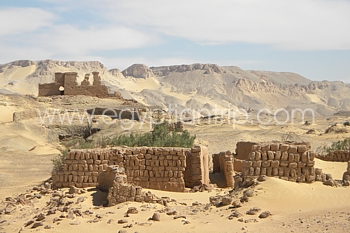 The Temple Of Ghweita The Temple Of GhweitaThe Temple of Ghweita or Qaser Ghweita, or the "fortress of deep springs" is located 25 kilometers to South of the city of Kharga. This temple together with the Temple of Hibis is the only temples built in Egypt during the Persian or Hyksos occupation, Situated on a summit, the sandstone fortress Qasr el-Gueita is a fortress that commands a strategic view of an ancient Western Desert trade route. Built and expanded by several Ancient Egyptian dynasties and Roman governors; the fortress contains a temple behind walls that take up to one-fifth of the space on the summit. The construction work of this temple started in the reign of Darius I over the top of a hill that was originally the ruins of a Pharonic settlement that goes back to the Middle Kingdom. The temple was built for the worship of the holy triad (Amun- Mut- Khonsu), the same as the temple of Hibis. It was also enlarged during the Ptolemaic era between the 3rd and 1st century BC. The Temple now includes a hall with 8 huge columns, a hypostyle hall, and a sanctuary. Qasr El-Zayyan A few kilometers south of Qasr El-Gueita, on the road leading south to Baris from Kharga, lies Qasr El-Zayyan, or what's left of it; the ruins of a fortress enclosing a temple. These ruins are exceptional compared to other ancient landmarks you may explore in the oasis; here, you'll find a lively village nearby, whereas usually the desert landmarks are always situated in uninhabited areas of barren desert. | |
|